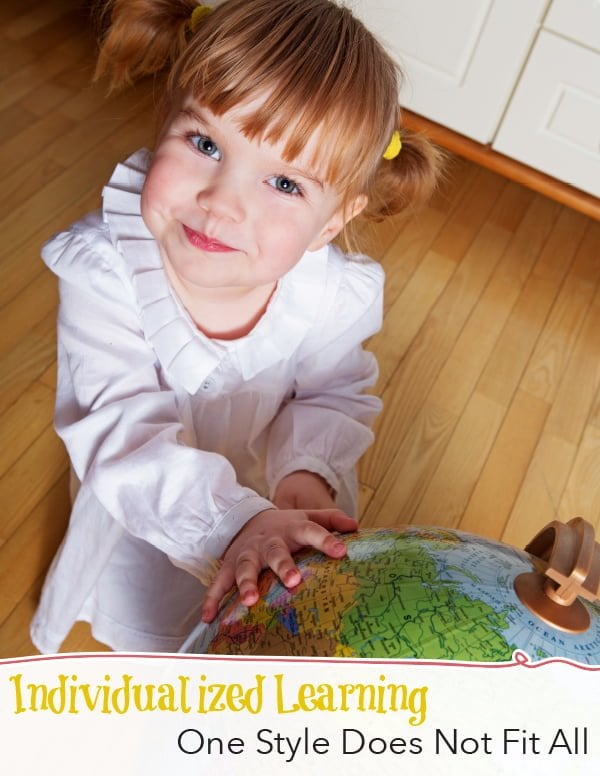Individualized Learning And Why One Education Style Doesn’t Fit All
If you feel like the educational system is too one-style-fits-all, you’re not alone. Many parents are exploring individualized learning through homeschooling, co-ops, hybrid schooling, and private schools. Oak Meadow founder Lawrence Williams weighs in on the topic of individualized learning.

Each of us tends to prefer one way of learning to another. Some learn best through reading. Others prefer to hear information spoken before they can make sense of it or remember it. Some need to see diagrams or demonstrations in order to develop understanding. Still others need to physically touch, manipulate, move, and experiment in order to relate to a given subject.
There are other ways of learning beyond these. For example, some children might benefit from a social environment filled with group activities; others need ample time for reflection.
One Learning Style Doesn’t Fit All
In previous generations, learning styles were not even acknowledged, much less accommodated. From one perspective, one could even say that the very concept of “learning disabilities” arose (and continues to arise) from an inability of some teachers and administrators to recognize and deal effectively with the different learning styles of children.
The concept that prompted much of the current debate over learning styles arose in the 1970s, with the left-brain/right-brain theory of neurological functioning. This prompted educators to view students as either left-brained learners (those that tend to approach things in a logical, linear or verbal manner) or right-brained learners (those that approached things in a more creative, spatial or holistic manner).
Gradually, however, this view began to lose favor, as further research indicated that the learning process involves a very complex interaction of both hemispheres simultaneously. Nevertheless, educators who focus on individualized learning recognized that the left-brain/right-brain concept, though incomplete, was true to a certain extent, that children do learn differently, and that teachers had to move beyond the purely logical-verbal approach traditionally used in schools and learn how to teach in ways that could appeal to a broader range of learning styles.
The Treasure Trove of Multi-faceted Intelligence
Recently, research on learning styles has increased considerably, and our understanding of these differences has grown. Two of the most prominent theories are those of Robert Sternberg of Yale and Howard Gardner of Harvard. In The Triarchic Mind, Sternberg proposed that there are three types of intelligence.
He calls these componential (the mind that is tested by IQ tests), contextual (the kind you use in creating new environments), and experiential (a practical or “street-smarts” kind of intelligence). Conventional school activities tend to focus upon componential intelligence, while contextual and experiential intelligence is what we tend to use in the everyday world. Naturally, this causes a problem for many children.
The theory that has been most widely acclaimed is that proposed by Howard Gardner. In Frames of Mind, Gardner synthesized evidence from brain research, psychological testing, experiments with animals, developmental work with young children, descriptive accounts of exceptional ability, and cross-cultural studies.
This evidence supported the idea that there are seven different kinds of intelligence: linguistic, logical-mathematical, visual-spatial, bodily-kinesthetic, musical, interpersonal and intrapersonal. He has since added an eighth type, naturalistic. These are not completely separate forms of intelligence, but rather aspects of the same intelligence that is within each of us. That is, we all have all eight types of intelligence in varying degrees, but generally one or more of these aspects tends to predominate, and this creates a particular style of learning for each individual.
How can we make sense of these various approaches when we’re homeschooling our children? How can we cooperate with individual learning styles to help our children learn more effectively?
There are so many creative options in working with a particular learning style. Often parents find themselves coming up with really imaginative activities on the spur of the moment.
The 8 Different Types of Learners
Here are just a few suggestions to give you an idea of the range of possibilities when it comes to individualized learning:
- Verbal-Linguistic learners like creative writing and word games; making up rhyming verse (perhaps in the form of rap music lyrics) about any subject can be very effective.
- Logical-Mathematical learners like logic problems and mysteries; they enjoy creating timelines for history or graphs for science.
- Visual-Spatial learners enjoy drawing pictures and maps, or creating puzzles and 3D models; they use imagery to understand so providing a visual aid is always helpful.
- Bodily-Kinesthetic learners can benefit from chewing gum or sitting on a ball while solving math problems; they like role-playing historical and literary characters.
- Musical learners benefit from translating facts into rhythmic forms (such as clapping while reciting multiplication tables); they may study best with music in the background.
- Interpersonal learners enjoy a dramatic production or group discussion; they appreciate problem solving with others, and connecting their studies to real-life situations.
- Intrapersonal learners enjoy reading biographies and watching plays or historical reenactments; they appreciate time for reflection and journal writing.
- Naturalistic learners benefit from observing the natural world, so field studies are especially important; literature and writing assignments can capitalize on this interest.
Knowing Individualized Learning Styles When You See It
You may find it interesting to evaluate yourself to determine your own learning style and note how it compares with that of your child. It can be helpful to take into account our own innate tendencies when working with children to ensure we are not unintentionally steering them toward our own preferences.
The purpose of identifying learning styles is to begin the process of identifying and appreciating our children’s unique ways of learning and expressing, and then to encourage that uniqueness by structuring school (and life) activities accordingly. As our children find joy in embracing the world through their unique learning styles, they gradually become able to explore other learning styles, other creative outlets, and other points of view. By starting with their strengths, we help them develop the confidence they need to tackle the greater challenges and opportunities that lie ahead.

